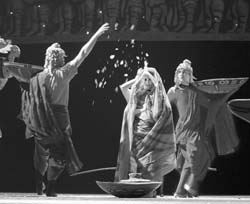Ethnography Indian-style
Franko Theater’s latest premiere pits the public against critics
The sound of Indian melodies, which are unusual to the Ukrainian ear, ring above the stage of the Ivan Franko National Theater. The initiation into the ancient culture of India took place during the company’s recent premiere of Shakuntala based on Mahabharata and Kalidasa’s plays. The plot of Shakuntala derives from the first of 18 books of the Mahabharata. It also served as the basis of Kalidasa’s 5th-century play. Sanskrit literature dating to the middle of the first millennium BC contains the following statement: “Kalidasa is the first among dramatists, and the first among Kalidasa’s dramas is Shakuntala.”
Andriy Prykhodko, the stage and music director, has undertaken the task of introducing Ukrainian audiences to the enigmatic and unique world of ancient Indian culture. His team of professionals and researchers includes Maria Pohrebniak (set design and costumes), Alla Rubina (choreography), Viktoria Shetlez-Virych (Hindu dance instructor), Natalia Osypenko (coach), Anatoliy Navrotsky (choirmaster), and Oleksiy Kitel (sound engineer). Lively, authentic music, played on national instruments, added to the atmosphere of the performance: Oleksiy Kabanov (sitar), Serhiy Puchkoiv (tablas), and Andriy Moroz (percussion). This music is the trembling, emotional tuning fork that sets the mood of this journey into an Indian fairytale, into an imagistic metaphorical world set against the backdrop of a love story featuring King Dushyanta and a maiden named Shakuntala. Their love begets a son named Bharata, the name the Hindus called their country. The plot can thus be regarded as a story about the origins of the Indian people, the nation of Bharata. The three short stories featured in the play are components of this ancient legend.
It would be no exaggeration to say that Prykhodko’s show is a breathtaking theatrical canvas. The play’s visual sequence is like the consecutive stages of a ritual that captivates the audience with the sheer beauty of the performance, concentrated meditation, and the mysterious tapestry of refined steps of Indian dance in the “odisa” style. This style, with its soft, moving vibrations of the body is most similar to tantra and ancient Indian sculptures. On stage the sculptural images that adorn the walls of numerous temples seem to come alive and carry the audience to a place where legend borders on real life. The viewer finds himself in a wonderland inhabited by huge creatures, fish, and birds. This entire revealed world is created in the manner of artistic primitivism featuring multicolored elephants, cows, fantastic sea creatures with curious trembling tails and fins, and magnificent bluebirds of happiness. Manipulated by actors, they walk, swim, and fly above the stage, filling it with their primeval beauty, compelling the audience to believe in the truthfulness of the myth about the sacred nature of these living creatures.
This wonder world, created in the theater through light (lighting director: Yaroslav Marchuk), video images, and other special effects creates the illusion of a boundless, starry universe where stardust can materialize into representations of ancient Hindu texts, the figure of Buddha, friezes from Hindu temples, and something else that is impossibly beautiful. This is an unfathomable world in which man is both weak and strong.
Like all legends, the myth of Shakuntala has a prescribed scheme. By means of a carefully thought-out imagistic vision of the plot, and the creation of a lively theatrical spectacle with a touch of mystery, the director takes the story beyond the limits of impartial myth. In this task the actors are his devoted helpers. Watching the cast — Larysa Rusnak (Shakuntala), Yaroslav Hurevych (Dushyanta), Anatoliy Pomyluiko (Kanva), Oleksandr Pecherytsia (Indra), Pavlo Piskun and Dmytro Chernov (hermits), and Kseniya Basha-Dovzhenko and Olena Medvedeva (female hermits) — one might assume that a Hindu troupe was visiting Kyiv. After mastering the plasticity of Indian dancing and wisdom of specific gestures, penetrating the mystery of the national character and the Hindu world view, and succeeding in introducing true Eastern intonations to their singing, the Franko cast succeeded in producing a blend of psychological and pictorial theater with an amazing degree of harmony. Here are the poetry of feelings, the mysterious nature of the world, the inscrutability of nature’s secrets, and the worshiping of the universe’s structure. The creators of the show build all these grand layers into a highly sophisticated structure in which the universe emerges as a primordial tale that is not deprived of the reality of ritual. “A man entering a woman’s womb is once again revived in the image of her son.” In this vivid manner the ritual gains the status of eternal law, a perpetual circle in which death begets new life, but life is not the irreconcilable antagonist of death.
Shakuntala is a colorful, emotional, and edifying play in which an inquisitive viewer will find food for thought and delight for his heart. This is how Andriy Prykhodko has imagined the origin of things whose place simply cannot be found in eternity. His vision may prove convincing to most, if not all. It is not important that Ukrainians are being told about their current realities on the basis of Indian culture. In the current reality the space under “nationality” has been left blank.






